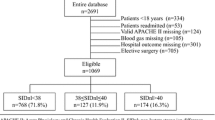Abstract
Plasma ionized calcium [Ca++] concentrations are decreased in patients having lactic acidosis. To further investigate this observation, we prospectively studied nine critically ill patients who had lactic acidosis and measured arterial pH, PCO2, [Ca++], lactate, and albumin concentrations. We found a strong association between decreased [Ca++] and increased plasma lactate concentrations (r 2=0.78,p≤0.001). This unexpected association — [Ca++] usually increases with increasing acidosis — might be clinically important and the mechanism deserves further investigation.
Similar content being viewed by others
References
Zaloga GP, Chernow B (1986) Hypocalcemia in critical illness. JAMA 256:1924–1929
Broder G, Weil MH (1964) Excess lactate: an index of reversibility of shock in human patients. Science 143:1457–1459
Aubier M, Viires N, Piquet J, Murciano D, Blanchet F, Marty C, Gherardi R, Pariente R (1985) Effects of hypocalcemia on diaphragm strength generation. J Appl Physiol 58:2054–2061
Lang RM, Fellner SM, Neumann A, Bushinski DA, Borow KM (1988) Left ventricular contractility varies directly with blood ionized calcium. Ann Intern Med 108:524–529
Desai TK, Carlson RW, Geheb MA (1988) Prevalence and clinical implications of hypocalcemia in acutely ill patients in a medical intensive care setting. Am J Med 84:209–214
Desai TK, Carlson RW, Thill-Baharozian M, Geheg MA (1988) A direct relationship between ionized calcium and arterial pressure among patients in an intensive care unit. Crit Care Med 16:578–582
Zaloga GP, Chernow B (1987) The multifactorial basis for hypocalcemia during sepsis. Ann Intern Med 107:36–41
Cooper DJ, Walley KR, Wiggs BR, Russell JA (1990) Bicarbonate does not improve hemodynamics in critically ill patients who have lactic acidosis: a prospective controlled clinical study. Ann Intern Med 112:492–498
Urban P, Scheidegger D, Buchmann B, Barth D (1988) Cardiac arrest and blood ionized calcium levels. Ann Intern Med 109:110–113
Siggaard-Andersen O (1984) The acid base status of blood, 4th revised edn. Munksgaard, Copenhagen, p 5
Feldman HA (1988) Families of lines: random effects in linear regression analysis. J Appl Physiol 64:1721–1732
Nawab ZM, Daugirdas JT, Ing TS, Leehey DJ, Reid RW, Klock MA (1984) Calcium-complexing versus vasorelaxant effect of acetate, lactate and other bases. Trans Am Soc Artif Intern Organs 30:184–188
Toffaletti J, Abrams B (1989) Effects of in vivo and in vitro production of lactic acid on ionized, protein bound, and complex-bound calcium in blood. Clin Chem 35:935–938
Author information
Authors and Affiliations
Additional information
Sources of support: BC Heart Foundation; BC Health Care Research Foundation; Canadian Heart Foundation
Rights and permissions
About this article
Cite this article
Cooper, D.J., Walley, K.R., Dodek, P.M. et al. Plasma ionized calcium and blood lactate concentrations are inversely associated in human lactic acidosis. Intensive Care Med 18, 286–289 (1992). https://doi.org/10.1007/BF01706475
Received:
Accepted:
Issue Date:
DOI: https://doi.org/10.1007/BF01706475




